Goerz 6x30 Monocle "Pernox"
| Ab 1902 gab es von Goerz das 6x30 Pernox-Modell. Dieses zeichnet sich durch eine ovale bzw. nierenförmige Deckelform (3fach verschraubt) aus und dadurch, dass das Prismensystem nur von oben eingesetzt werden kann; während die Unterseite ein Teil des Gußgehäuses ist. Siehe dazu das Foto eines offenen binokularen Pernox-Modells mit herausgenommenen Prismenkäfig. Das hier gezeigte Modell ist eine 6x30 Version mit der im Kreisbogen angeordneten Beschriftung "C.P. Goerz Berlin, Pernox Monocle, D.R.Pat" am oberen Deckel, darunter die verschlungenen Initialien 'C.P.G.'. Am Objektivende des Gehäuses sitzt ein schwarz lackiertet Metallring mit der Seriennummer 120498 (Jahr 1907). Hier ist der leicht konische Objektivtubus angeschraubt. Das Pernox ist aus Messing und Aluminium mit einer Lederummantelung am Gehäuse inklusive Unterseite und Objektivtubus. Das linksseitige Okularstück hat eine Augenmuschel aus Bakelit und einen geriffelten Fokussierungsring. Die Augenmuschel ist drehend montiert, so dass sie sich beim Fokussierung nicht mitdreht, wenn sie am Auge ist. Die Dioptirenskala ist von + bis - 5 markiert und läuft um das ganze Okularstück. |
Since 1902 the 6x30 Permox model was produced by Goerz Berlin. This glass features a oval or kidney shaped cover plate with threee screws and a body cast in one piece with no lower cover plate. The prism system is put in from the top. The photo shows an opened Pernox bincualr with its pulled-out prism cage. The model shown here has a circular inscription at the top cover: "C.P. Goerz Berlin, Pernox Monocle, D.R.Pat" (D.R. Pat = German Empire Patent). Below are the interwoven initials 'C.P.G'. The bottom side of the housing has a black painted metal ring marked with serial number 120498 (1907). Here the slightly concial objective tube is screwed in. The Pernox is made of brass and aluminium with a leather covering at its body includinmg its bottom part and objective tube. The left-hand sided eyepiece has a Bakelite eyecup and a knurled focusing ring. The eyecup is turnables, so it stays in place when the focussing ring is turned. The dioptre scale is marked from + to - 5 and goes all the way round the ocular. |
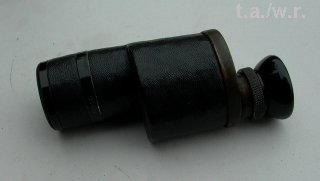
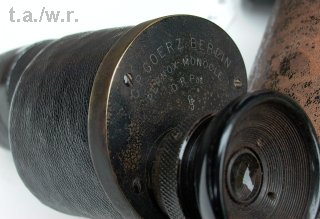
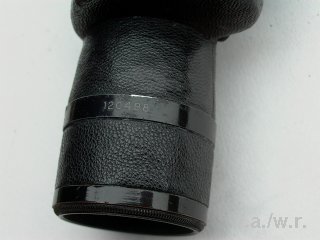
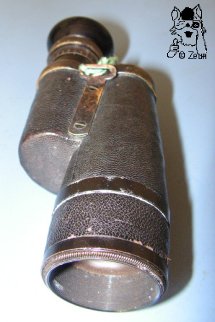
| Am Gehäuse ist ein 35mm langer Metallstreifen mit einer Trageöse befestigt- Das Pernox 6x30 wiegt 288g, es ist zwischen 122 und 130mm lang. Das nierenförmige Prismengehäuse ist 42mm x 54mm breit, an der schmalsten Stelle 38mm. Der Objektivtubus hat einen Durchmesser von 39mm; am unteren Gehäuse beginnt der konische Tubus mit einem Durchmesser von 35mm. Das Okularstück ist 21,5mm im Durchmesser, der Fokusierungsring 28,6mm und die Augenmuschel 34,5mm. |
There is a 35mm long metal strip with a strap lug attached to the housing. The Pernox 6x30 weighs 288g, it measures between 122 and 130mm in length. The kidney shaped prism housing is 42mm x 54mm wide, the narrowest part being 38mm. The objective tube has a diameter of 39mm. The conical tube starts at the bottom part of the housing with 35mm. The eyepiece is 21.5mm in diameter, the focussing ring 28.6mm and the eyecup 34.5mm. |
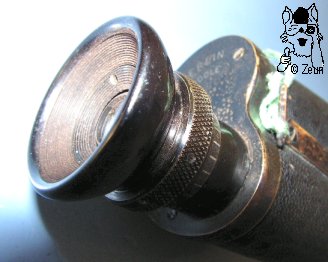
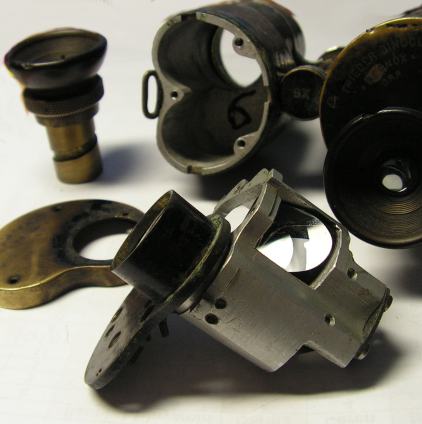
| Ein weiteres 6x30 Pernox Exemplar hat ein rechtsseitiges Okular ohne drehbare Augenmuschel. Diese ist aus Messing. Ubten am Gehäuse ist über das Leder eine schwarz lackiter Messingplatte geschraubt. Somit wiegt das Exemplar 319g. Evtl. wurde es für das Militär so konstruiert. Am oberen umgestülpten Deckelrand ist sowohl die vergrößerun "6x" als auch die Seriennummer "143734" (Produktionsjahr 1908)eingraviert. | Another Pernox 6x30 specimen has a right-hand sided ocular without turnable eyecup. The latter is made of brass. There also is a black painted brass plate screwed onto the leather of the bottom of the housing. This specimen weighs 319g. It was probably constucted this way for military use. The magnification "6x" and the serial number "143734" are engraved at the rim of the top cover plate (year of production 1908). |
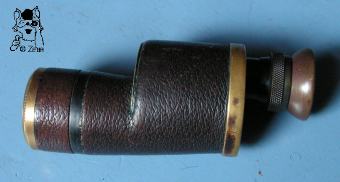
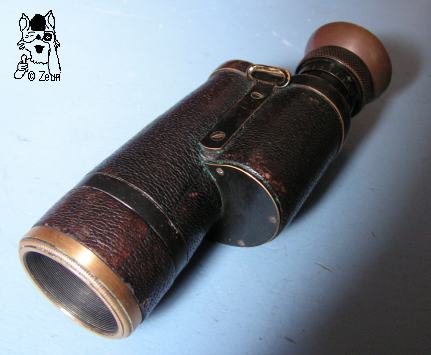
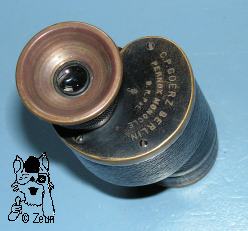
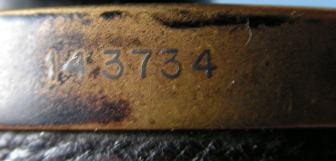
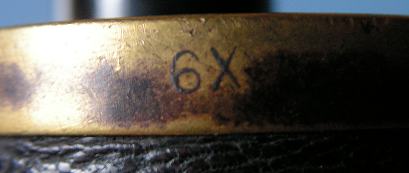
Fotos: 1-3 Antoniades, 4-10 Zeun

